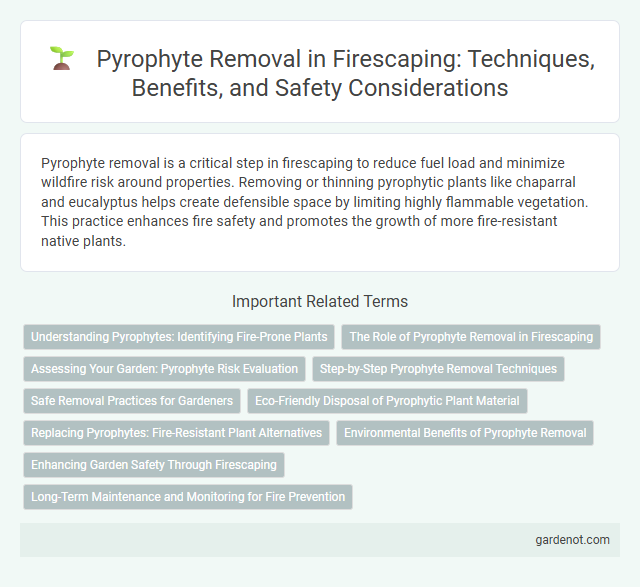Pyrophyte removal is a critical step in firescaping to reduce fuel load and minimize wildfire risk around properties. Removing or thinning pyrophytic plants like chaparral and eucalyptus helps create defensible space by limiting highly flammable vegetation. This practice enhances fire safety and promotes the growth of more fire-resistant native plants.
Understanding Pyrophytes: Identifying Fire-Prone Plants
Pyrophytes are plants adapted to survive and thrive in fire-prone environments, often containing flammable oils and resins that increase wildfire risks. Identifying common pyrophytic species, such as eucalyptus, chaparral, and certain pines, is crucial for effective firescaping and reducing potential fuel loads. Removing or managing these fire-prone plants helps create defensible spaces that mitigate fire spread and protect property.
The Role of Pyrophyte Removal in Firescaping
Pyrophyte removal plays a critical role in firescaping by reducing the density of fire-adapted plants that can act as fuel during wildfires. Targeted elimination of pyrophytes, such as certain species of pine and eucalyptus, minimizes the risk of rapid fire spread and helps create defensible space around properties. Effective pyrophyte management enhances ecosystem resilience while protecting human habitation from severe fire damage.
Assessing Your Garden: Pyrophyte Risk Evaluation
Evaluate your garden's pyrophyte risk by identifying plant species prone to intense burning, such as eucalyptus and certain pines. Conduct thorough inspections to assess the density and proximity of pyrophytic vegetation near structures, focusing on foliage moisture content and resin levels that increase flammability. Use this assessment to develop targeted removal or replacement plans aimed at reducing wildfire hazards while maintaining ecological balance.
Step-by-Step Pyrophyte Removal Techniques
Step-by-step pyrophyte removal techniques involve identifying and prioritizing the removal of fire-prone vegetation such as chaparral, manzanita, and dry grasses around the property perimeter. Begin by cutting back dense pyrophyte clusters to reduce fuel load, followed by carefully applying targeted herbicides or controlled mechanical removal to prevent regrowth. Regular maintenance, including clearing dead plant material and monitoring for invasive pyrophytes, supports long-term fire risk reduction in firescaping strategies.
Safe Removal Practices for Gardeners
Pyrophyte removal requires careful attention to fire safety protocols to prevent accidental ignition during garden maintenance. Gardeners should use non-sparking tools, clear dry brush from the work area, and maintain a water source nearby for immediate fire suppression. Wearing protective clothing and disposing of pyrophyte debris away from ignition sources further ensures a safe and controlled removal process.
Eco-Friendly Disposal of Pyrophytic Plant Material
Eco-friendly disposal of pyrophytic plant material involves using methods such as chipping, composting, or controlled biomass burning to minimize environmental impact. These practices reduce the risk of fire hazards while promoting nutrient recycling and supporting soil health. Proper disposal aligns with sustainable firescaping by maintaining ecosystem balance and preventing invasive species propagation.
Replacing Pyrophytes: Fire-Resistant Plant Alternatives
Replacing pyrophytic plants with fire-resistant alternatives reduces wildfire risk by incorporating species with high moisture content and low flammability, such as succulents, lavender, and native Oregon grape. These fire-resistant plants create defensible space around structures while enhancing landscape aesthetics and biodiversity. Selecting appropriate drought-tolerant, low-volatility species is critical for effective firescaping and long-term fire mitigation.
Environmental Benefits of Pyrophyte Removal
Removing pyrophytes significantly reduces fuel loads, lowering wildfire intensity and promoting landscape resilience. This management practice supports biodiversity by allowing native, fire-sensitive species to regenerate and thrive. Furthermore, pyrophyte removal enhances soil stability and water quality, minimizing erosion and runoff in post-fire environments.
Enhancing Garden Safety Through Firescaping
Pyrophyte removal plays a critical role in enhancing garden safety through firescaping by eliminating highly flammable vegetation that can rapidly spread wildfires. Clearing dense pyrophytic plants such as eucalyptus, pine needles, and certain grasses reduces fuel load and creates defensible space around properties. Regular maintenance and strategic plant selection further minimize fire hazards, promoting a safer, fire-resistant landscape.
Long-Term Maintenance and Monitoring for Fire Prevention
Long-term maintenance and monitoring of pyrophyte removal are essential to reduce wildfire risks by minimizing flammable vegetation near structures. Regular inspections and targeted trimming prevent regrowth of highly combustible plants such as chaparral and manzanita, maintaining defensible space. Integrating drought-tolerant, fire-resistant species with continuous clearing protocols enhances landscape resilience and supports effective fire prevention strategies.
Pyrophyte removal Infographic

 gardenot.com
gardenot.com